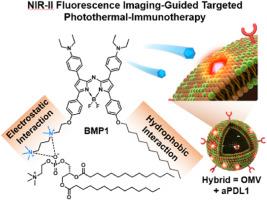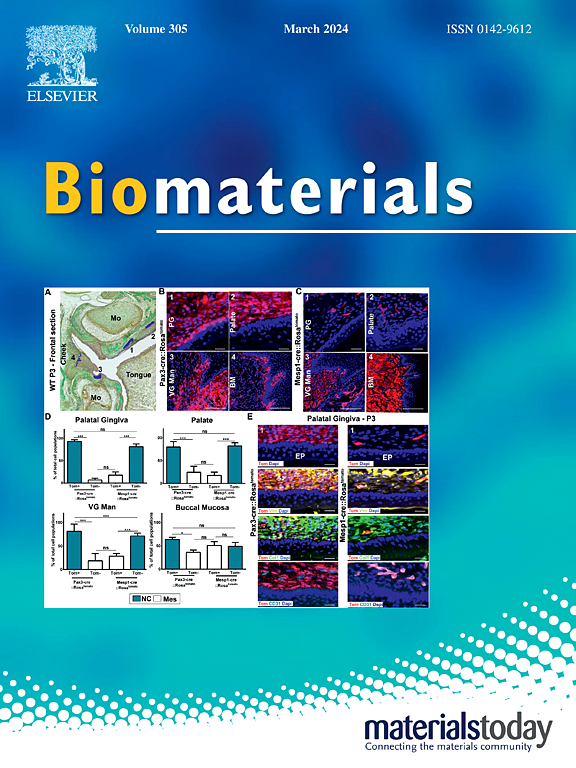NIR-II fluorescence membrane probes for rapidly labelling hybrid of probiotic outer membrane vesicles and anti-PD-L1 scFv over-expressing cellular vesicles with targeted photothermal-immunotherapy of colon cancer
IF 12.9
1区 医学
Q1 ENGINEERING, BIOMEDICAL
引用次数: 0
Abstract
Lipid-bilayer structured nanovectors (LBSNs) (e.g., liposomes and biomimetic vesicles) are burgeoning for diagnosis and therapy, and fluorescence labelling is often conducted for biodistribution tracing with visible/NIR-I fluorescence membrane probes (MPs). As NIR-II fluorescence imaging exhibits significantly improved fidelity, we synthesize NIR-II emissive donor-acceptor structured BODIPY-based MPs (BMP1-2) to label LBSNs composed of immunogenic probiotic outer membrane vesicles and cellular nanovesicles over-expressing anti-PD-L1 scFv, yielding BMP@Hybrid with tandem-amplified immunotherapy. The compact BMPs contain dodecyl chain and few cationic charges, forming strong electrostatic and hydrophobic interaction with negatively charged LBSNs, respectively. This contributes to features including negligible harm to biofunction of LBSNs, high photothermal conversion capability, good photostability, balanced lipophilicity, fast staining on LBSN within 2 min under mechanical stirring with ultrahigh ON/OFF ratio (>115), which offering wash-free imaging. Notably, BMP1@Hybrid could actively target tumor, facilitating biodistribution tracing, colon cancer diagnosis, and molecular imaging of tumoral microenvironments. Remarkably, BMP1@Hybrid efficiently destructs primary tumor by photothermal effect, blockades PD-1/PD-L1 axis, and modulates tumoral microenvironment with promoting secretion of inflammatory cytokines, M2-to-M1 macrophage repolarization, dendritic cell maturation, local infiltration of CD8+ T cells, and boosted therapeutic outcomes. This study provides a new strategy of NIR-II fluorescence membrane probes for the labelling of LBSNs and precise cancer theranostics.

NIR-II荧光膜探针快速标记益生菌外膜囊和抗pd - l1过表达scFv细胞囊的杂交光热免疫治疗结肠癌
脂质双分子层结构纳米载体(LBSNs)(如脂质体和仿生囊泡)在诊断和治疗方面正在蓬勃发展,荧光标记通常用于可见/NIR-I荧光膜探针(MPs)的生物分布追踪。由于NIR-II荧光成像具有显著提高的保真度,我们合成了NIR-II发射供体-受体结构的基于bodipi的MPs (BMP1-2),用于标记由免疫原性益生菌外膜囊泡和细胞纳米囊泡组成的LBSNs,通过序列扩增免疫疗法获得BMP@Hybrid。紧凑的bmp含有十二烷基链和少量的阳离子电荷,分别与带负电荷的LBSNs形成强烈的静电和疏水相互作用。这使得LBSN具有以下特点:对生物功能的危害很小,光热转换能力强,光稳定性好,亲脂性平衡,在机械搅拌下2分钟内快速染色,具有超高开/关比(>115),可提供免水洗成像。值得注意的是,BMP1@Hybrid可以主动靶向肿瘤,促进生物分布追踪、结肠癌诊断和肿瘤微环境的分子成像。值得注意的是,BMP1@Hybrid通过光热效应有效地破坏原发肿瘤,阻断PD-1/PD-L1轴,调节肿瘤微环境,促进炎症细胞因子分泌、M2-to-M1巨噬细胞再极化、树突状细胞成熟、CD8+ T细胞局部浸润,提高治疗效果。本研究为NIR-II荧光膜探针标记lbsn和精确肿瘤治疗提供了一种新的策略。
本文章由计算机程序翻译,如有差异,请以英文原文为准。
求助全文
约1分钟内获得全文
求助全文
来源期刊

Biomaterials
工程技术-材料科学:生物材料
CiteScore
26.00
自引率
2.90%
发文量
565
审稿时长
46 days
期刊介绍:
Biomaterials is an international journal covering the science and clinical application of biomaterials. A biomaterial is now defined as a substance that has been engineered to take a form which, alone or as part of a complex system, is used to direct, by control of interactions with components of living systems, the course of any therapeutic or diagnostic procedure. It is the aim of the journal to provide a peer-reviewed forum for the publication of original papers and authoritative review and opinion papers dealing with the most important issues facing the use of biomaterials in clinical practice. The scope of the journal covers the wide range of physical, biological and chemical sciences that underpin the design of biomaterials and the clinical disciplines in which they are used. These sciences include polymer synthesis and characterization, drug and gene vector design, the biology of the host response, immunology and toxicology and self assembly at the nanoscale. Clinical applications include the therapies of medical technology and regenerative medicine in all clinical disciplines, and diagnostic systems that reply on innovative contrast and sensing agents. The journal is relevant to areas such as cancer diagnosis and therapy, implantable devices, drug delivery systems, gene vectors, bionanotechnology and tissue engineering.
 求助内容:
求助内容: 应助结果提醒方式:
应助结果提醒方式:


